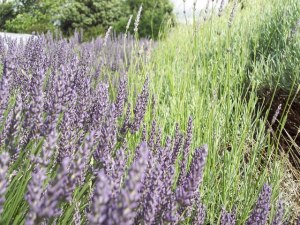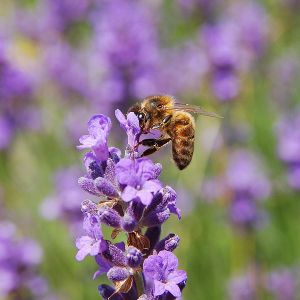
Lavender (‘Lavandula’ botanically) is one of Mint’s many cousins, and has 39 different species within its genus. By far the most common are Lavandula dentata (French/Italian Lavender) and Lavandula augustifolia (English Lavender); you rarely see any of the others growing around Sydney.
Popular with aromatherapists and naturopaths, Lavender’s medicinal potential is (extremely) old news; the ancient Greeks knew of its calming properties, and it was used extensively in hospitals during World War 1. Its flower spikes are incredibly versatile; they’re used in dried flower arrangements and potpourris, teas, baked goods, as cake decorations, even (apparently) as a substitute for confetti at weddings. Apiarists will tell you that the honey made by bees fed on Lavender nectar is some of the best in the world, and it sells for king’s ransom in Europe.
But forget all this – unless you’ve got a several-acre backyard you won’t be growing lavender for its skills. You’ll be after its outrageous good looks.
Lavender flowers like crazy almost all year round; soft purple spires rising from a mass of delicate grey foliage. It smells as good as it looks too, and it’s a sure-fire way to bring in the birds and bees (literally; this is a family blog).
So how do you grow it? There are really only two main things to consider; drainage and pruning.
Lavenders like a drink but their roots love to rot; if you’ve got even a trace of clay in your Lavender bed they’re done for. If planting them in the ground it’s best to dig down about 600-700 millimetres, then spread a layer of sand about 100 millimetres deep. Backfill the rest of the hole with really free-draining soil mix, loaded with organic matter. Four Seasons Nursery has all the sand and soil you’ll need, in bulk and in bags. We can also help you out if your garden bed is nothing but clay, with a variety of soil conditioners and a heap of smiley advice-giving staff to talk you through it.
Aside from moisture the only other way a Lavender will spoil is if it is left alone for too long. They are the polar opposites to orchids; they need attention, frequently, in the form of a stylish haircut. Trimming your Lavender by up to about a third of its size eve
 ry few months will stop it from developing the gnarly wooden ‘trunks’ they get, and keep it a nice dense bush with scores of flowers. Once they go woody there’s no going back; they’ll never be as dense and there will never be as many flowers. It’s pretty much a write-off at this point, which is sad and expensive. So keep your shears sharp, clean and close, maybe under your pillow, so you never forget. Your Lavender will thank you and you’ll have a perfect excuse to get a new pillow every couple of weeks. How good are fresh pillows! Very good.
ry few months will stop it from developing the gnarly wooden ‘trunks’ they get, and keep it a nice dense bush with scores of flowers. Once they go woody there’s no going back; they’ll never be as dense and there will never be as many flowers. It’s pretty much a write-off at this point, which is sad and expensive. So keep your shears sharp, clean and close, maybe under your pillow, so you never forget. Your Lavender will thank you and you’ll have a perfect excuse to get a new pillow every couple of weeks. How good are fresh pillows! Very good.And that’s pretty much it. Keep them in your sunniest spot, keep them well fed, and keep an eye out for the usual suspects; aphids, mealy bug and co (though Lavenders have pretty good pest-resistant levels). Plant them in groups of at least 5 for best effect; the more the merrier with Lavender. We at Four Seasons Nursery have scores of them for sale, in different sizes and cultivars. Come choose a few today!
Cheers,
Mike.
No comments:
Post a Comment